Assignment 4 Report
Design of Interface Application
Introduction
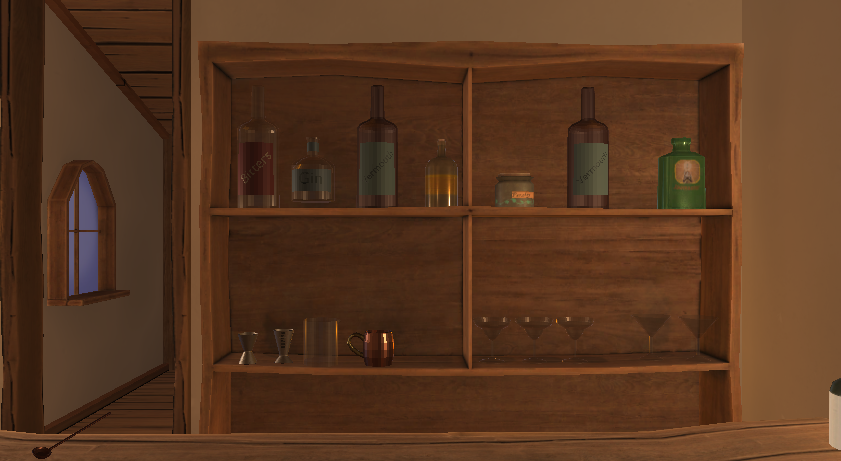
This report will provide an in-depth look at the development of immersive interface applications utilizing virtual reality (VR) technology. The world of training and education is evolving rapidly, and technology is at the forefront of this change. One of the innovations is using virtual reality (VR) in training interfaces to meet the needs of various fields. As we all know, bartending is more than just bartending. Traditional training methods, while effective, often require significant time and resources, sometimes resulting in wasted materials. However, traditional training methods can be resource-intensive and require more immediate feedback. Therefore, the Virtual Bartending Academy aims to bridge these gaps. It provides a portable, convenient solution that turns novices into experts. This is achieved through an immersive VR experience replicating a real-life bartending scenario without the clutter or cost associated with an actual practice. This report will delve into the purpose, functionality, importance, and details of the Virtual Bartending Academy.
“Virtual Bartending Academy is your loyal VR bartending instructor, turning anyone into a skilled bartender through immersive, feedback-rich training, all without spilling a drop.”
Description of the application
The Virtual Bartending Academy is a cutting-edge virtual reality (VR) application meticulously crafted using the Unity platform. It mirrors the intricacies of an authentic bar environment, offering users a hands-on experience in drink mixing, pouring, and serving. Drawing inspiration from the "duality of virtual interfaces," the application is categorized into distinct modes:
Simulation Mode: This mode replicates a genuine bar environment, enabling users to delve into bartending practices, acquaint themselves with tool placement, and understand the mechanics of a standard bar setup. Users can use VR controllers to pick up virtual objects, pour concoctions, and meaningfully interact with their surroundings. An emphasis has been laid on providing real-time visual and auditory feedback, from the clink of ice cubes to virtual customers voicing their contentment or critique. This mode's simulation ensures a practical experience without the risk of wasting actual ingredients or the chance of real-world mishaps.
Training Mode: This segment is driven by a gamified approach. As users opt for this mode, they're ushered into a time-bound challenge wherein they must prepare drinks listed on a virtual menu. Successful concoctions yield scores, and integrated quizzes and assessments further gauge users' proficiency and preparedness for tangible bartending situations.
Interactive Replication: The Academy does not just simulate; it immerses. It boasts an elaborate visual setup with bottles, glasses, blenders, and even animated patrons eager for service. The VR landscape is responsive, capturing the essence of bartending actions, from the feel of pouring to the sound of shakers.
The impetus for leveraging VR for such an endeavour is manifold. Traditional bartending education, though effective, often comes with its own set of constraints—expense, resource consumption, and potential confusion. In contrast, the Virtual Bartending Academy offers:
Waste Minimization: Classic bartending pedagogies often witness ingredient wastage. With our VR interface, practice sessions are ecologically and economically conscious. Furthermore, users sidestep the hassle of scheduling physical classes, eliminating worries about missed sessions due to unforeseen events.
Safe Practice Arena: The novice bartender sometimes finds the real-world setting intimidating, leading to accidental mishaps. The virtual realm of our academy provides a sanctuary where they can hone skills without taking risks, building their confidence step by step.
Adaptive Feedback System: Real-time feedback is integral to our app. If a user falters in drink preparation, a virtual patron's dissatisfaction nudges them to re-evaluate and rectify their approach, ensuring continuous learning.
Cost-Efficiency: After its initial development, our app is a one-time investment, circumventing recurring expenses inherent in traditional training—for resources, utilities, or trainers.
The Virtual Bartending Academy is more than just a simulation—it is a holistic solution to challenges plaguing conventional training modules.
Description of the interface solution
Significance of VR Technology: VR technology is essential to the experience of Virtual Bartending Academy. Without VR technology, there will be a significant detraction from the program's efficiency compared to traditional mediums such as keyboard and mouse. This is due to the necessity of using your hands to practise bartending skills. The use of VR helps encompass several critical requirements to create a realistic and effective bartending training environment:
Realism: VR allows for a more realistic experience than traditional technology mediums. This is due to being able to use your hands, move around, and the screen moving with your head.
Justification for VR Technology Selection: VR was chosen over other interface technologies due to its unparalleled suitability for bartending training as it allows:
Hands-On Practice: The VR interface helps facilitate skill development, allowing users to practise drink preparation and pouring without real-life waste, as bartending skills require physical dexterity and muscle memory; these can be honed through hands-on practice. VR provides a tangible means to achieve this without being in a bar.
Safety: VR eliminates the risks associated with practising bartending in the physical world, allowing users to build confidence without fear of mishaps causing actual harm.
Skill Enhancement: The VR interface helps foster skill development by offering a safe and realistic practice area. Users can receive immediate feedback, enabling continuous improvement and skill refinement. Compared to real life, the Virtual Bartending Academy can have different levels of difficulties, so you can build your confidence and improve over time as well as skill ratings to give direct feedback instantaneously and an idea of where you are at.
Cost-Effectiveness: Our academy does not require a more experienced bartender to watch over you and help you, costing the business money; instead, it allows you to work on your skills whenever you want to and only costs the initial payment.
Interaction Design
Storyboard for Application
The relationship between the interface technology and the application is imperative for this application's effectiveness and operation. These ‘interactions’ immerse the user and create more effective education towards bartending. As previously mentioned, VR is an effective interface to educate trainee bartenders. The VR interactions which are critical to designing a successful program include:
- Allowing the user to grab their tools and containers with the controllers.
- Measurement of volume of respectful liquids in containers.
- Spill detection on floor or counter.
- Transfer of liquid from containers.
- Background bar noises.
- Interactive Menu
- Potential extras to include: chopping, shaking, and stirring.
These are the significant interactions that are to be implemented in the design. Allowing the user to grab parts of the environment is necessary, but other elements have more niche reasoning behind their implementations. Allowing the program to accurately understand the volume in particular containers is essential, as completing the recipe accurately is a significant skill for a bartender. Similarly, spill detection adds a similar element of realism to the design. Background noise also increases immersion through a different mode of sensation. A key element in this application's design process was creating an authentic experience similar to a bartender’s experience in the workplace.
Initial technical Development
This project is being developed in Unity using the Oculus Quest 1 headset, and we are using the Oculus integration package found in the Unity asset store to support this.
Our team are currently working on the following:
Setting up the environment
The bar environment, which will be made using the “Pirate Tavern” package from the Unity store, created by “PollyPrivateers” will set the scene for the user. They will be surrounded by common bar furnishings and ambience.
Creating a menu for the selection of drinks and the difficulty
The user can open the menu from the bar and select from several drinks and difficulties.
Creating liquid physics for pouring
This is an integral part of our project. We are working on a means of pouring liquids in Unity, intending to have them be measurable.
Creating 3D models to represent bartending tools and ingredients
The Unity asset store did not have the items that we needed for this project freely available, so we have been creating them ourselves using Blender.
Once all of these elements have been completed, we will be able to incorporate them into our Unity project and create the interactions as described in the above section.
Our planned tasks for technical development are as follows:
Creation of levels
Levels must be created, each with different drinks, and ways of measuring the completion of the instructions must be implemented.
Creating interactions between objects
Some objects will interact with each other differently; for example, we may wish to allow the user to place olives on a toothpick and have the olives stay in place on the toothpick as part of making a martini.
Detection of mistakes/spillage
Colliders will be used to detect and measure the amount of liquid spilled on the bar / on the ground.
Development of the scoring and timing system
The completion of each level will be timed, and a score will be given upon completion of the level, which will take into account the time taken, as well as spillage and mistakes.
Integration of varying difficulties/instruction visibility
Varying difficulties will be introduced to encourage skill progression. As the aspiring bartender gains skill, they will require fewer instructions/time to make each drink.
Possible addition of humanoid models (customers)
Humanoid models would create a more realistic bar environment. This is something that we would like to include if we can.
Possible addition of endless mode
A mode where drinks are ordered one after another to allow the aspiring bartender to experience the pressure and repetition of the occupation would be a great addition to the training application. It is something we are hoping to include.
Initial 3D Models
The models we intend to include in our application are as follows:
From the Unity asset store:
Pirate Tavern, created by PollyPrivateers and found in the Unity asset store - This will be our bar environment. The package comes with a premade tavern, which includes a bar, tables, chairs, and various other furnishings.
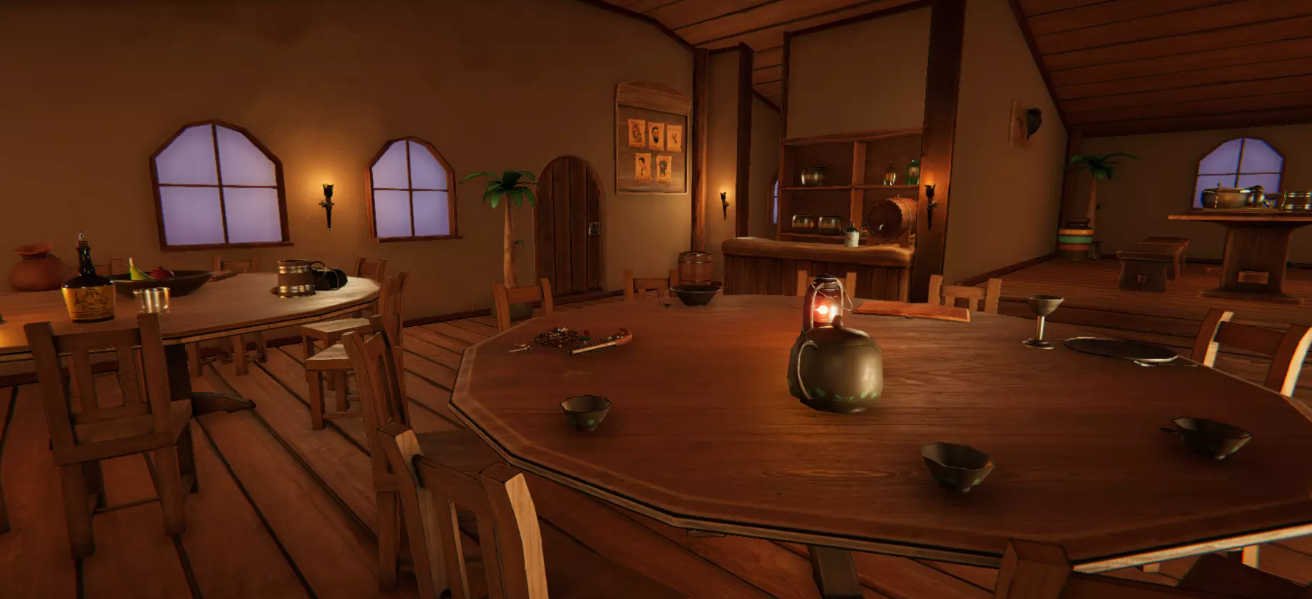
The main models from this package that the user will interact with are the bar and the shelves.
The bar will be the main preparation surface; the user will use this as a platform for mixing and serving drinks.
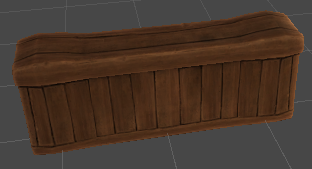
The shelves will hold the ingredients necessary for the preparation of the drinks.
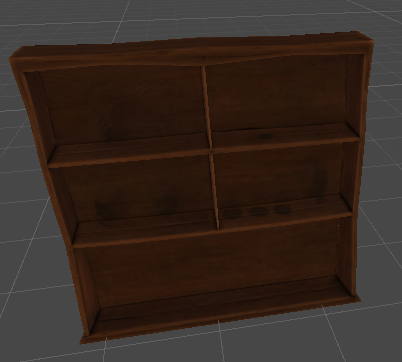
The rest of the bar environment will be for ambience and immersion.
Made by us:
Martini glass, margarita glass, and Moscow mule mug - vessels for drinks.

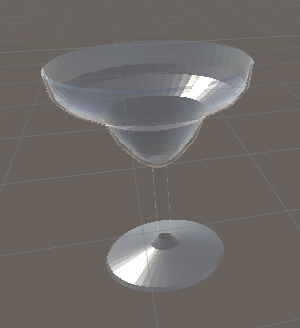

Bitters bottle, gin bottle, and vermouth bottle - bottles to hold liquids used in the drinks.
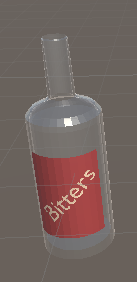
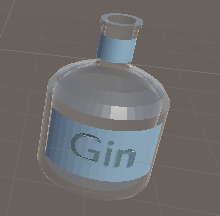

Mixing glass - a vessel to mix drinks before they are served.

Jiggers - common bartender measuring vessels that we will be using to measure liquids.

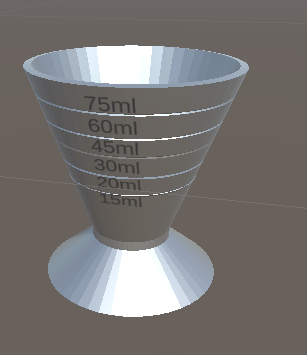
Ice cube - for putting in the drinks, usually whilst the drink is being stirred or shaken.
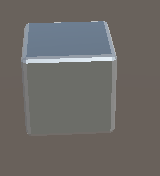
Long spoon - a utensil the user can use for stirring drinks.

Strainer - will allow the user to strain the drink into the glass.
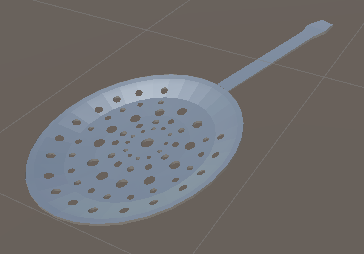
Olive and toothpick - can be used together to create a garnish for martinis.
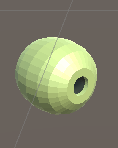

Several other models will be created before the release of the application. There are no screenshots at this time, but these are listed below.
Ginger beer, vodka, tequila, Cointreau and lime juice bottles - to hold liquids used in drinks.
Lime slice - for garnishing the Moscow mule and the margarita (we may give users the ability to cut the lime themselves, in which case a cutting board, a knife, and a half lime model would also be ideal).
Containers or bowls for the olives and the toothpicks - so that they are not loose.
Salt - for salting the rim of the margarita glass.
Shaker - for shaking the margarita ingredients before serving.
Conclusion
The Virtual Bartending Academy is a groundbreaking application that uses virtual reality (VR) technology to revolutionize bartending education. This report provides a comprehensive overview of the application's development, interface design, and technical details.
Built on the Unity platform, the Virtual Bartending Academy offers an immersive and realistic bartending experience. It has three distinct modes: Simulation Mode, Training Mode, and Interactive Replication, designed to enhance learning outcomes while minimizing resource wastage and ensuring user safety.
The decision to use VR technology as the interface for this application is justified by its ability to provide a highly realistic and hands-on training environment. VR enables users to practice bartending skills, develop muscle memory, and receive immediate feedback without real-world risks or costs.
The interaction design of the application is meticulously planned to ensure a seamless and authentic bartending experience. Users can grab tools, measure liquids, detect spills, and engage with various elements of the virtual bar environment, all contributing to effective skill development.
The technical development of the Virtual Bartending Academy involves the creation of a bar environment, menu system, liquid physics, 3D models for bartending tools and ingredients, and various levels of difficulty. Integrating these elements, interactions, mistake detection, scoring, and potentially humanoid models, aims to provide users with a comprehensive and challenging training experience.
This report highlights the significance of VR technology in vocational education, as supported by relevant references, and presents a promising solution to the challenges faced by traditional bartending training methods.
In summary, the Virtual Bartending Academy is a cost-effective, safe, and highly immersive training experience that has the potential to become an invaluable tool for anyone aspiring to master the art of bartending.
References
Report References:
Chinthammit, W. & Wells, L, Virtual and Mixed Reality Technology week 2: Virtual Interface, School of ICT, University of Tasmania, viewed 5 October 2023, Lecture - Virtual Interfaces - KIT208 KIT724 Virtual and Mixed Reality Technology and Virtual and Mixed Reality Technology (utas.edu.au)
Chinthammit, W. & Wells, L, Virtual and Mixed Reality Technology week 4: Human Computer Design Process, School of ICT, University of Tasmania, viewed 5 October 2023, Lecture - Human Computer Design Process - KIT208 KIT724 Virtual and Mixed Reality Technology and Virtual and Mixed Reality Technology (utas.edu.au)
Mulders, M. (2022) Vocational training in virtual reality: A case study using the 4C/ID model, MDPI. Available at: https://www.mdpi.com/2414-4088/6/7/49 (Accessed: 07 October 2023).
Peterson, G.B., Petkakis, G. and Makransky, G. (2022) A study of how immersion and Interactivity Drive VR Learning, University of Copenhagen. Available at: https://www.sciencedirect.com/science/article/pii/S0360131521003067 (Accessed: 07 October 2023).
Ravichandran, R. and Mahapatra, J. (2023) Virtual Reality in Vocational Education and Training: Challenges and Possibilities. PSS Central Institute of Vocational Education, Available at: https://www.researchgate.net/publication/370286311_Virtual_Reality_in_Vocational_Education_and_Training_Challenges_and_Possibilities (Accessed: 08 October 2023).
Development References:
3 Ways to CUT HOLES in Objects in Blender (2020). The CG Essentials. 9 March. Available at: https://www.youtube.com/watch?v=kUwra0cM4To.
Amazon.com: 45ml/30ML jigger for bartending, stainless steel double ... (no date) amazon. Available at: https://www.amazon.com/Bartender-Jigger-Cocktail-Bartending-Stainless/dp/B08HX5J239.
Beginners Guide for Making Martinis (2020). Steve the Bartender. 30 May. Available at: https://www.youtube.com/watch?v=75k7dsINNQ0.
Create Curved Text In Blender | Bend Any Text | Part 1 in Text Effects | Two Easy Methods Explained (2021). 5 Minutes Blender. 23 March. Available at: https://www.youtube.com/watch?v=qumU349VpWE.
Oculus integration: Integration (2023) Unity Asset Store. Available at: https://assetstore.unity.com/packages/tools/integration/oculus-integration-82022.
Pirate tavern: 3D fantasy (2018) Unity Asset Store. Available at: https://assetstore.unity.com/packages/3d/environments/fantasy/pirate-tavern-113463.
POV: Bartender Making Cocktails at a Top London Restaurant (Summer Drinks!) (2023). Fallow. 7 June. Available at: https://www.youtube.com/watch?v=XYm9ywkR6Fg.
Schulfer, S. (2023) 18 popular drinks every bartender should know how to make, Complete Bar Inventory Software System. Available at: https://home.binwise.com/blog/drinks-every-bartender-should-know.
What is a jigger? (no date) WebstaurantStore. Available at: https://www.webstaurantstore.com/blog/2932/what-is-a-jigger.html.
Zambas, J. (2022) How to become a bartender (duties, salary and steps), CareerAddict. Available at: https://www.careeraddict.com/become-bartender.
Zambas, J. (2023) 30 most stressful jobs (and how much they pay), CareerAddict. Available at: https://www.careeraddict.com/stressful-jobs.
Leave a comment
Log in with itch.io to leave a comment.